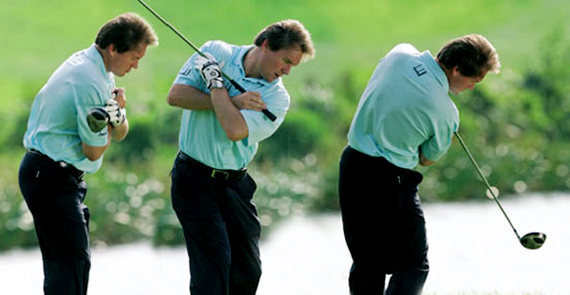Tuition
Logical Golf
by Robert BakerLesson 10 – The perfect example of generating energy with the body ‘core’ The ‘core’ of the body is like the centre of the carousel wheel. Vijay Singh’s belt area is, in effect, his motor – the faster he turns the motor, the more the gearing effect that accelerates the rim of the wheel (i.e. the clubhead).
None of this would work, of course, without a wrist action that transmits and multiplies the centrifugal forces down through the shaft and into the clubhead (hence the need to keep a constant eye on your grip).
All it takes is a slight trigger from the left ankle (or knee) to initiate the downswing and the motor comes to life.
There is an upward pulling motion of the left hip while the right knee and thigh kick in to assist in the powerful on-line delivery of the club to the ball.
The better the rhythm, the more speed there is on tap through impact.
When you look at someone like Vijay, perhaps the perfect example of a player who understands the importance of unwinding from the ground up, the swing takes on a sort of elastic property.
Vijay releases the club so ‘late’ that when he finally throws the clubhead through the ball, his right hand actually comes off the grip.
He is free-wheeling.
The core energy is such that it has been transmitted down through the arms and the shaft and into the clubhead. The job is done. I use this incredible image to press home the message that for a truly flowing and dynamic motion you must learn to swing through positions – not to them. I encounter a lot of amateur golfers who are too technical in their thinking, and who try to create positions rather than generate a free-flowing motion.
If you want to realise your true potential for speed and distance, take a tip from the new world No.1: develop speed with your core, trust it, and simply let it go.
When a golfer gets nervous, having little or no confidence in his swing, there is a tendency for the hips and the stomach to slow down at exactly the time they should be speeding up. The turning motion effectively stops through the impact area, all ‘lag’ in the wrists is lost and the hands are forced to take over (which inevitably leads to a flipping action through and beyond impact).
Contrast this with the dynamics of a good player turning all the way through the shot, generating terrific centrifugal force with the ‘core’ – like Vijay.
Good players place the emphasis on the core for the simple reason that this is where the bulk of their ‘dynamic speed’ comes from.
One of the key lessons I hope you take from this supplement is that only by unwinding your swing from the ground up are you able to utilise your stomach muscles as you rotate hard through the ball.
The faster the stomach moves, the greater the acceleration of the clubhead, and the more compelling the momentum of the swing all the way through to the finish. These are what I regard as the key dynamics in a good swing.
And the more you are able to study and visualise these moves, the better you will become at making them. [octo_single_image image=”113491″ img_size=”full” alignment=”center”]
From the setup, think of your body core as the hub of the swing
[octo_single_image image=”113492″ img_size=”full” alignment=”center”]
Think ‘right pocket back’ for a level hip turn, and let left knee ease in
[octo_single_image image=”113493″ img_size=”full” alignment=”center”]
Chain reaction: as the ankles roll back towards the target, the left hip climbs while the right shoulder works ‘under’
[octo_single_image image=”113494″ img_size=”full” alignment=”center”]
Turning motion from the ‘hub’ spins the rim of the wheel (i.e. the clubhead)
